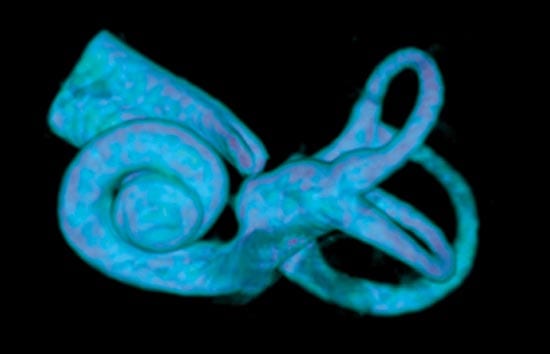
The Spiral Secret to Mammal Hearing
... and other recent research findings by WHOI scientists
The spiral secrets of mammals? hearing abilities
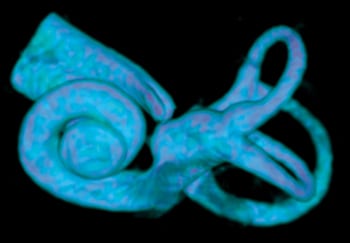
Inside their inner ears, mammals (but not other animals) have cochleas—coiled shell-like tubes in which incoming sound energy tilts sensory hairs, generating electric signals to the brain. Scientists thought coiled cochleas evolved as a way to pack a longer tube length into the available skull space, giving mammals better low-frequency hearing than other vertebrates, which lack cochleas.
To test the idea, Darlene Ketten, a biologist at Woods Hole Oceanographic Institution (WHOI), and WHOI researcher Julie Arruda provided high-resolution CT scans, taken at the WHOI Computerized Scanning and Imaging Facility, of cochleas from 13 different land and marine mammal species. They included creatures whose hearing abilities are well-documented, ranging from an elephant, mouse, and human to a sea lion and a bottlenose dolphin.
From the CT images, Ketten’s group made precise geometric measurements of all the cochleas and sent the images, drawings, and data to a research team led by Daphne Manoussaki, a mathematics professor at Vanderbilt University, and Richard S. Chadwick of the National Institute on Deafness and Other Communication Disorders, who calculated the cochleas’ curvatures. They found that the less tightly wound the spiral in an animal’s cochlea (or put more mathematically, the broader the ratio of its curvature), the lower the frequency of sounds the animal could hear. The findings suggest that lower curvature improves the focus and penetration of lower-energy, low-frequency sound waves along the inner ear walls, channeling sound more efficiently to the cochlear tips and making sounds more audible—just as in a whispering gallery.
The research, published April 22, 2008, in the Proceedings of the National Academy of Sciences as the featured news item, could be extrapolated to improve understanding of hearing (and the impact of human-made noises) in animals whose auditory abilities remain unknown, such as tigers and polar bears, and even extinct mammals, such as land and aquatic ancestors of whales, saber-toothed tigers, and woolly mammoths, whose cochleas are often preserved as fossils.
—Kate Madin
This study was funded by the National Institutes of Health, Vanderbilt University, the Technical University of Crete, and the Office of Naval Research Marine Mammal Program.
Photo: Researchers in the WHOI Computerized Scanning and Imaging Facility produced this high-resolution CT scan image of a human cochlea, an organ inside the inner ear, as well as cochlea images from a dozen other different land and marine mammals. Scientists compared the curvature of the cochleas to uncover a secret about why they have spiral shapes. (WHOI CSI Facility)
A smorgasbord of microbes feasts on a banquet of fresh seafloor rock
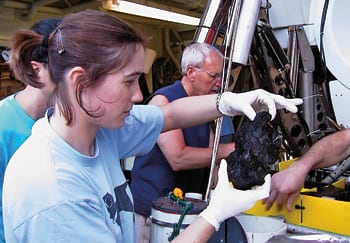
“We were truly shocked to find microbial life thriving at the levels we observed,” said Cara Santelli, a recent graduate of the MIT/WHOI Joint Program and lead author of a study published May 28 in the journal Nature.
Santelli conducted the research with geochemists Katrina Edwards (University of Southern California) and Wolfgang Bach (University of Bremen) while all three were at Woods Hole Oceanographic Institution, as well as collaborators from Western Washington University, the Marine Biological Laboratory, and Scripps Institution of Oceanography.
“Theoretical research by Edwards and Bach suggested that life could exist in such a dark, cold, and rocky environment,” Santelli said. “The objective of our project was to provide tangible evidence. Not only was the biomass in seafloor lava greater than in the overlying seawater, but the bacterial diversity was significantly greater than we could have imagined.”
The findings raise new questions about the evolution of life on the seafloor and on Earth.
“We are just beginning to scratch the surface,” Santelli said. “What role does this microbial community play in global ocean chemistry? What sort of metabolism is needed to live in and dominate this environment? And what exactly are these microbes doing down there?”
—Mike Carlowicz
Photo: Biogeochemist Cara Santelli examines a microbe-laden seafloor rock recovered by the Alvin submersible. (Courtesy of Cara Santelli, WHOI/Harvard)
Scientists uncover unsuspected source of iron in the ocean
M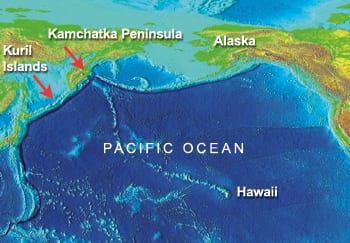
Scientists have assumed that phytoplankton blooms are fertilized by iron-containing dust particles blown off continents and out to sea by wind, or by iron-rich waters from the deep sea that are brought up to the sunlit surface by currents. But iron in seawater samples collected on a 2005 research cruise in the northwest Pacific Ocean clearly did not come from these two sources.
James Bishop of the University of California, Berkeley, and Phoebe Lam of Woods Hole Oceanographic Institution found high concentrations of particulate iron 100 to 200 meters beneath the surface. The iron was far less oxidized than it would be if it came from dust from Earth’s surface. Instead the iron was characteristic of volcanic material from the margins of the Kamchatka Peninsula and the Kuril Islands. The scientists say the iron-rich material originated in sediments at these margins and traveled out to sea along a dense, deep-water layer. Storms or currents can bring the iron up toward the surface for use by plankton.
“We suspect this is the case for the iron supply in other, similar regions of the oceans,” Lam said. The study was published April 2008 in Geophysical Research Letters.
A picky eater, the butterfly fish may face extinction
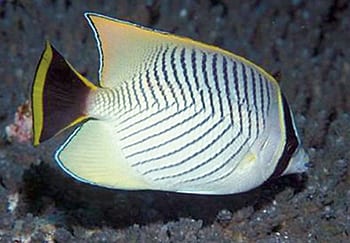
“The irony is that these butterflyfish are widespread around the world, and you’d have thought their chances of survival were pretty good,” said Morgan Pratchett, a scientist at James Cook University. “But they only eat one sort of coral—Acropora hyacinthus—and when that runs out, the fish just disappear from the reef.”
Prachett and Michael Berumen, a biologist at Woods Hole Oceanographic Institution, found it hard to believe a fish would starve rather than eat a mixed diet, so they tested a particular species of butterflyfish in tanks on a range of different corals. The fish grew well when its favorite coral was available, but when this was removed and other sorts of corals offered, they grew thin, and some died.
The fish’s lack of dietary diversity makes them less adaptable as their sole food source faces stress from pollution and climate change, the scientists said in a study published in the journal Behavioural Ecology
and Sociobiology.
Photo: Courtesy of ARC Centre of Excellence for Coral Reef Studies
Earth’s tectonic plates may move intermittently
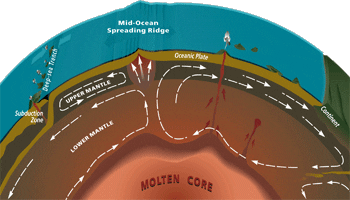
Now two scientists have added a revolutionary wrinkle: The crustal conveyor belt may stop and start, said Paul Silver of the Carnegie Institution of Washington and Mark Behn of Woods Hole Oceanographic Institution in the Jan. 4, 2008, issue of the journal Science.
“The scientific community has typically assumed that plate tectonics is an active and continuous process, that new crust is constantly being formed while old crust is recycled,” Behn said. “But evidence suggests that plates may move actively at times, then stop or slow down, and then start up again.”
Silver and Behn calculated that the Earth could not always have released heat from its interior as fast as it is doing today (or else Earth’s surface would have been entirely molten in the recent past). Assessing isotopic data in ancient rocks, they found that the Earth virtually stopped releasing heat about 1.5 billion years ago. Their explanation? Plate tectonics temporarily slowed or ceased, clamping a lid on escaping heat.
“If the tectonic plates are moving,” Behn said, “the Earth releases heat more efficiently and cools down faster. If you don’t have those cracked and moving plates, then heat must get out by diffusing through the solid rock, which is much slower.”
—Mike Carlowicz and Lonny Lippsett
Illustration by Jayne Doucette, Woods Hole Oceanographic Institution
From the Series
Related Articles
- The story of a “champion” submersible
- Robots to the Rescue
- Who is Alvin and what are sea trials?
- 7 Places and Things Alvin Can Explore Now
- The story of “Little Alvin” and the lost H-bomb
- Meet the Alvin 6500 Team: Lisa Smith
- Overhaul to take Alvin to greater extremes
- Meet the Alvin 6500 Team: Rose Wall
- Racing an undersea volcano
